Australia and New Zealand offer a stunning mix of mountains, deserts, reefs, forests, beaches, and vibrant multicultural cities that continue to captivate travellers. Meanwhile, the Pacific Islands, with their remote charm, white sands, and crystal-clear waters, feel like scenes from a dream.

Melbourne’s most iconic laneway for street art, Hosier Lane is a cobbled stretch of urban creativity that attracts camera-toting crowds from around the world. Covered in vivid layers of graffiti, stencils, murals, and mixed-media installations, the lane offers a raw and ever-changing expression of political, social, and countercultural themes—often laced with sharp humour and striking beauty.
The street art spills over into Rutledge Lane, which loops around and reconnects with Hosier Lane. This constantly evolving canvas is painted and repainted, often overnight. While technically most of the artwork is unauthorized, it’s widely tolerated—and no two visits are ever the same.
Street art walking tours frequently include Hosier Lane along with other graffiti-rich laneways such as AC/DC Lane, turning Melbourne’s hidden alleys into an open-air museum.
Since Hosier Lane’s rise to global fame in the 1990s, it has hosted works by a who’s who of street art, including international names like Banksy—whose 2003 Parachuting Rat was accidentally removed by city workers in 2010—as well as Shepard Fairey (USA), Invader (France), D*FACE (UK), and ABOVE (USA). Homegrown talents such as Rone, Ha Ha, and Prism have also left their mark.
Melbourne’s street art roots go back to the 1980s, influenced by New York’s graffiti scene. Originally focused on train carriages and tracks, the movement eventually migrated into the city’s dark laneways. Over time, tags gave way to intricate stencils, paste-ups, installations, and even sculpture.
As bars, cafés, and restaurants emerged along these tucked-away alleys, the city began embracing street art as part of its cultural identity. Today, many walls across Melbourne host commissioned murals—but Hosier Lane remains the spiritual heart of this creative movement.
In 2020, ten masked individuals sprayed the entire lane using fire extinguishers filled with colourful paint—an act condemned as vandalism by authorities. Whether a protest against the commercialization of Hosier Lane or simply an attention-seeking stunt, the art scene bounced back quickly. The lane was cleaned, and fresh pieces began appearing almost immediately.
Hosier Lane is located directly opposite Federation Square, at the southern end of Melbourne’s CBD, just off Flinders Street. Nearby landmarks include:
Federation Square (Fed Square) – home to ACMI (Australia’s national museum of screen culture) and the Ian Potter Centre: NGV Australia.
Forum Theatre – a grand 1920s picture palace turned live music venue.
MoVida – A beloved Melbourne institution, this Spanish tapas restaurant sits at the southern end of the lane.
Tres a Cinco – A colourful Mexican cantina serving tacos and tequila, taking the place of the former Misty cocktail bar.
Tip: Visit early in the day for fewer crowds and better light for photography. Or come back at night to see the art under the glow of nearby neon and streetlamps.
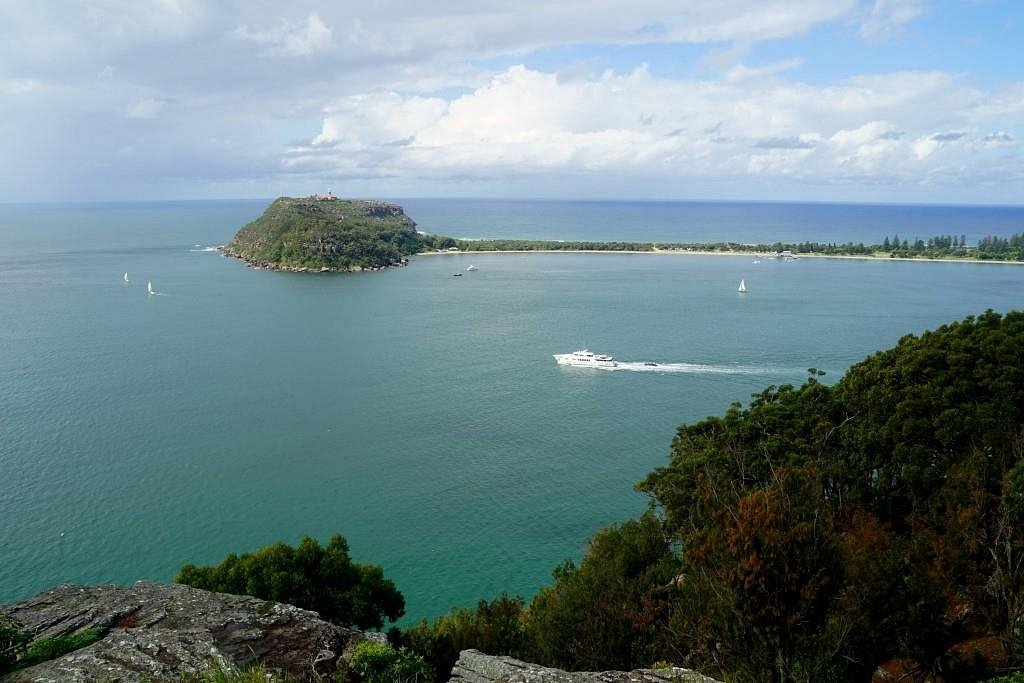
A spectacular blend of sandstone cliffs, native bushland, and serene waterways, Ku-ring-gai Chase National Park spans 14,928 hectares and forms the northern boundary of Sydney. Located just 20 to 30km from the city centre and easily accessible by public transport, it’s a perfect day-trip destination for nature lovers, history enthusiasts, and outdoor adventurers.
As Australia’s second-oldest national park, established in 1894, Ku-ring-gai is named after its original custodians, the Guringai people, whose deep cultural connection to the land endures despite the tragic consequences of colonisation. More than 800 Aboriginal sites have been preserved throughout the park, including ancient rock engravings, middens, and cave art—offering a powerful glimpse into Australia’s pre-colonial past. For a moving historical perspective, consider reading The Secret River by Kate Grenville.
The park’s rugged beauty stretches over 100km of coastline along Broken Bay and the lower Hawkesbury River. It’s divided into two main areas:
Bobbin Head: Featuring a marina, picnic areas, a café, and a mangrove boardwalk.
West Head: Offering panoramic lookouts across Pittwater and Broken Bay.
Barrenjoey Headland: At Palm Beach, home to an historic lighthouse and breathtaking views.
Walking & Hiking
Take advantage of the elevated terrain and well-maintained trails offering sweeping views over Cowan Creek, Pittwater, and the Hawkesbury. The Bobbin Head Information Centre, run by NSW National Parks & Wildlife Service, is a great place to begin your walking adventure.
Waterfalls & Swimming
Upper Gledhill Falls: A scenic and relatively easy-to-reach waterfall, popular for wild swimming.
Duck Hole (or Duck Pond): A tranquil spot on McCarrs Creek with gentle cascades and a sandy bank—ideal for a refreshing dip.
Camping
For a remote nature escape, head to The Basin Campground, accessible only by ferry. It offers basic facilities (toilets, showers, drinking water, picnic tables), but campers must be well-prepared. All sites must be pre-booked via the NSW National Parks & Wildlife Service website.
Picnicking
The park is dotted with scenic picnic spots equipped with toilets, water taps, and in some cases, barbecue areas—perfect for a relaxed afternoon outdoors.
Whale Watching
In winter, Ku-ring-gai offers excellent vantage points for spotting migrating whales off the coast.
Entry fees apply per vehicle and per person per day, as is standard across Australian national parks. For the latest pricing and payment options, visit the NSW National Parks & Wildlife Service website.
By car:
For West Head, access via McCarrs Creek Rd, off Mona Vale Rd (Terrey Hills).
For Bobbin Head, use Bobbin Head Rd (North Turramurra) or Ku-ring-gai Chase Rd (Mount Colah).
By ferry: Access to The Basin Campground and nearby areas via Palm Beach water taxi.
Camping at The Basin.
YHA hostels in nearby Pittwater and Collaroy.
Houseboats on the Hawkesbury River for a unique overnight stay.
Sydney Lakeside Holiday Park in Narrabeen, offering cabin and camping facilities.
Tip: Whether you’re hiking to a lookout, paddling through creeks, or exploring Aboriginal heritage sites, Ku-ring-gai Chase National Park delivers a rich and rewarding taste of wild New South Wales—just beyond the city.

Standing 182 metres above sea level, Maungakiekie, also known as One Tree Hill, is one of Auckland’s most iconic landmarks. Once the largest and most spiritually significant Māori pā (fortified village) in the region, this volcanic cone offers sweeping 360-degree views of the city and both its harbours.
At its summit stands an obelisk dedicated to the Māori people, alongside the grave of Sir John Logan Campbell, often called the ‘father of Auckland’. He gifted the surrounding 230-hectare parkland to the city in 1901 and requested the memorial to acknowledge the Māori who had been dispossessed through colonisation.
The name One Tree Hill has long been part of Auckland’s identity, but today, the summit is home only to a stump and a story. The original tōtara tree, sacred to Māori, was felled in 1852 by a European settler—whether out of disregard or simply for firewood remains debated.
In response, John Logan Campbell planted Monterey pines, and only one survived the decades. That too was felled in 2000 in a symbolic act by a Māori activist protesting the New Zealand government’s fiscal envelope policy on Treaty of Waitangi settlements.
In 2015, native trees were planted on the summit—including tōtara and pōhutukawa—with the intention that, in time, a single tree may stand once more.
Walks & Views: Enjoy panoramic views from the summit, but leave time to explore Cornwall Park, which surrounds the hill. The park is filled with mature trees, wide walking paths, grazing sheep and cattle, and Auckland’s oldest surviving home, Acacia Cottage (1841).
Information Centre: The Cornwall Park Information Centre includes fascinating interactive exhibits that depict what Maungakiekie looked like when it was home to around 5,000 people.
Stardome Observatory & Planetarium: Located near the children’s playground, the Stardome offers immersive planetarium shows and stargazing sessions, typically held Wednesday to Sunday evenings, with extra weekend sessions.
The name Maungakiekie means “mountain where kiekie (a native vine) grows abundantly.” The land was once home to the Te Wai ō Hua iwi, and many other iwi also trace ancestral connections to this maunga. Its terraces and storage pits remain visible, providing a direct link to its past as a thriving Māori settlement.
This sacred site also inspired the U2 song One Tree Hill, featured on their 1987 album The Joshua Tree. The track was a tribute to Greg Carroll, a New Zealander and friend of Bono’s, who worked with the band as a roadie. Carroll tragically died in a motorcycle accident in Dublin, and the song commemorates their first night together in Auckland, when he took Bono to the summit of One Tree Hill.
By Train: Take the train to Greenlane Station, then walk about 1km along Green Lane West.
By Car: From the Southern Motorway, take the Greenlane exit, then turn right into Green Lane West. Parking is available within Cornwall Park.
Maungakiekie is more than a scenic viewpoint—it’s a site of deep cultural memory, layered history, and quiet reflection. Whether you’re walking through its fields or standing at its summit, this sacred volcanic cone offers a powerful connection to Auckland’s past and present.
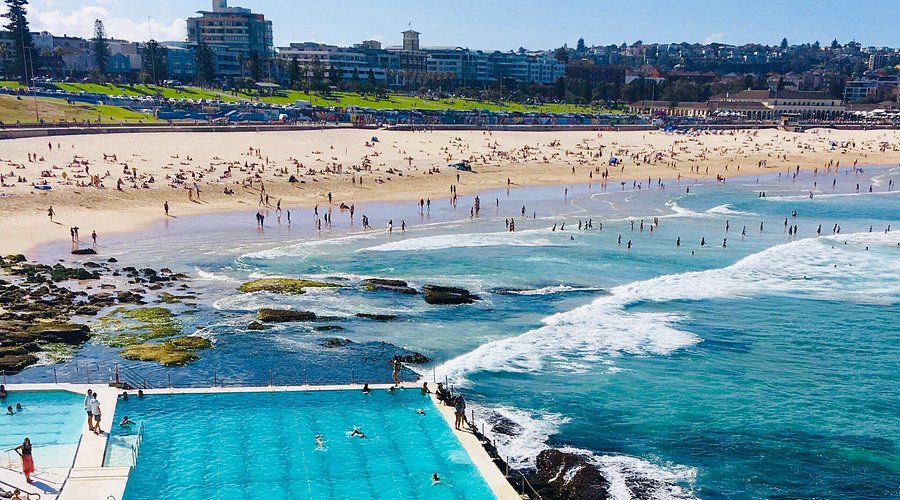
Quintessentially Sydney, Bondi Beach is one of the world’s most famous stretches of sand. Just 8km from the city centre, it offers consistently good waves, an energetic vibe, and a golden crescent of sand that’s perfect for a rough-and-tumble swim. With average water temperatures around 21°C, it’s swimmable year-round.
Bondi caters to all types of beachgoers:
Strong surf? Take a plunge into the child-friendly saltwater sea baths at both ends of the beach, beautifully upgraded in 2019.
Surfers flock to the sandbar breaks at either end—ideal for both pros and first-timers.
At the northern end, you’ll find a grassy area with coin-operated barbecues, perfect for a seaside picnic (just note: alcohol is banned on the beach).
Facilities include changing rooms, lockers, and beach-accessible wheelchairs (free to book via Bondi Pavilion).
Bondi is also a vibrant social hub.
LGBTQIA+ beachgoers often gather near the North Bondi Surf Club, home to a popular outdoor workout area and one of the beach’s most inclusive spaces.
And of course, there’s Bondi Pavilion, a central landmark hosting exhibitions, performances, and community programs.
Two surf clubs—Bondi Surf Club and North Bondi Surf Club—patrol the beach. Red-and-yellow flags mark the safest areas to swim. With thousands of rescues every year, it’s crucial to follow lifeguard instructions and stay within designated zones.
Bondi’s lifeguards are among the most experienced in the world, managing everything from powerful rip currents to bluebottle stings.
Bondi Rescue, the hit TV series, has showcased their work since 2006.
The Bondi Surf Bathers’ Life Saving Club, founded in 1907, was the first surf lifesaving club in the world, established at a local pub by concerned swimmers.
Sharks may make headlines, but incidents are rare.
Shark nets help protect swimmers from large species like great whites.
Lifeguards and surfers also keep watch, and shark alarms (such as the 2019 false alarm caused by a baby shark) are taken seriously.
Bondi offers accommodation for every type of traveller:
Bondi Backpackers – Social, central, and steps from the sand.
Baxley Bondi – Boutique charm with a minimalist touch.
Dive Hotel – Beachfront with relaxed, homely vibes.
QT Bondi – Stylish and modern, with a splash of luxury.
Tip: Bondi is more than just a beach—it’s a lifestyle. From coastal walks to weekend markets, surf lessons to sunset swims, this iconic spot captures the spirit of Sydney in every salty breeze.
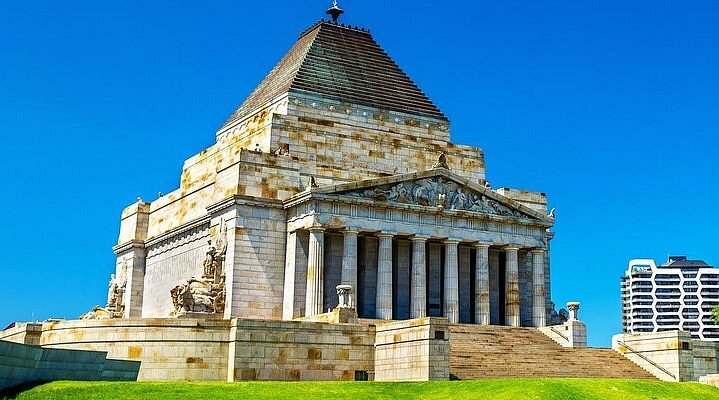
A defining landmark of Melbourne, the Shrine of Remembrance stands as a powerful tribute to all Victorians who have served in war and peacekeeping missions—especially the 19,000 who died in World War I. Commanding in both presence and symbolism, the shrine is one of Australia’s most significant war memorials.
The shrine draws thousands each year to its ANZAC Day Dawn Service on 25 April, and to the Remembrance Day Service at 11am on 11 November, marking the hour the Armistice was signed in 1918. At that exact moment, a shaft of light shines through an aperture in the ceiling, illuminating the word “Love” engraved on the Stone of Remembrance—a moving symbol of national mourning and hope. On other days, this effect is recreated hourly with artificial light.
Outside, the forecourt includes a cenotaph and the eternal flame, first lit by Queen Elizabeth II in 1954, honouring those who died in World War II. The surrounding gardens and monuments commemorate various regiments and military campaigns, making the entire precinct a place of layered remembrance.
Beneath the shrine lies a striking contemporary museum space: the Galleries of Remembrance. With over 800 artefacts, photographs, and artworks, these exhibitions trace the personal and collective stories of Australians at war—from Gallipoli to peacekeeping missions in recent decades.
Constructed between 1928 and 1934, the shrine was built largely with Depression-era sustenance labour. Its stoic classical design draws inspiration from the Mausoleum at Halicarnassus, one of the Seven Wonders of the Ancient World.
From the upper balcony, visitors are rewarded with sweeping panoramic views of Melbourne, including a straight visual corridor up Swanston Street. To preserve this sightline, planning regulations still prohibit buildings from obstructing the view of the shrine from as far back as Lonsdale Street—a rare urban planning decision that honours historical memory.
Free app: Download the Shrine of Remembrance app for a self-guided tour.
Guided tours: Available daily (free for veterans and current ADF/NZDF members).
Kids’ activities: Four themed explorer cards are available, along with a fun Explorer Kit—including a periscope, magnifying glass, and kaleidoscope—borrowed from the Visitor Centre.
Security & Tradition: The site is under 24-hour police guard, and officers on duty during opening hours wear replica WWI light horse uniforms, reinforcing the connection between past and present.
Whether you’re tracing Australia’s military history, attending a solemn service, or admiring the architecture and views, the Shrine of Remembrance offers a deeply moving and meaningful experience.
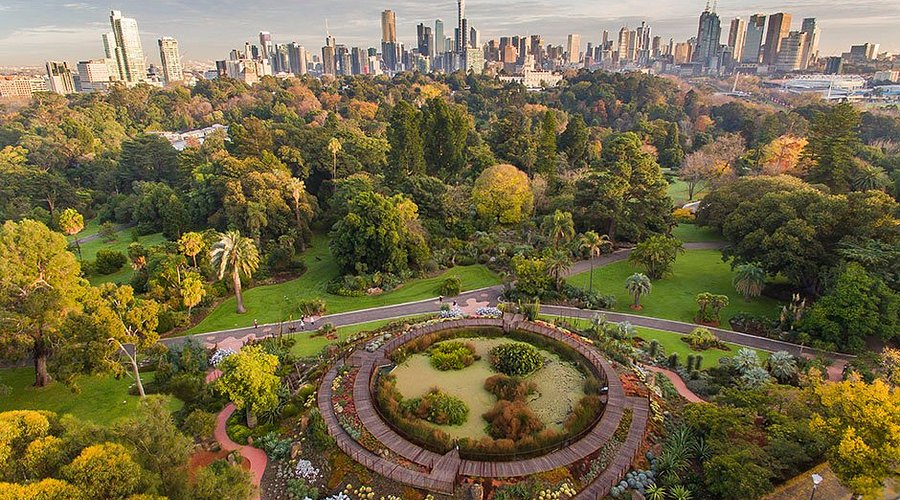
Considered one of the world’s finest examples of Victorian-era landscape design, Melbourne’s Royal Botanic Gardens attract over two million visitors annually. Spanning 38 hectares, the gardens are a tranquil, green sanctuary just minutes from the CBD—home to curated plant collections from around the world and a spectacular showcase of Australian native flora.
From above, the gardens resemble a pair of giant green lungs, breathing life into the city with vast lawns, black-swan-dotted lakes, mini ecosystems, herb gardens, and a tucked-away indigenous rainforest.
In Summer
Moonlight Cinema transforms the lawns into a pop-up theatre under the stars, showing cult classics and new releases.
Open-air performances bring stories like Shakespeare and Wind in the Willows to life, often in family-friendly formats.
For Kids
The Ian Potter Foundation Children’s Garden is a nature-based wonderland designed at a child’s scale—complete with interactive features, shaded nooks, and water play.
Cultural Significance
Don’t miss the Aboriginal Heritage Walk, led by a local First Nations guide. You’ll learn to identify native plants used for food and medicine, and gain insight into the deep cultural connection to country held by the Kulin Nation, the Traditional Custodians of the land.
The fact that this lush space was spared from early urban development speaks to its cultural and ecological importance.
Science & Discovery
Visit the Visitor Centre (near Gate E) to book walking tours.
Nearby, the National Herbarium of Victoria—established in 1853—holds over 1.5 million preserved plant specimens used for scientific research and plant identification.
At Night
The historic Melbourne Observatory, built in the 1860s, offers guided stargazing tours and astronomy talks.
No day at the gardens is complete without a good coffee or leisurely meal. A standout is Jardin Tan, a French-Vietnamese café located near Gate F, known for its fresh, seasonal menu and garden-grown ingredients.
If Melbourne’s gardens leave you wanting more, head to the Royal Botanic Gardens Cranbourne, an extension located in the outer suburb of Cranbourne. The Australian Garden here offers 10 kilometres of walking tracks through bushland and dryland landscapes, with a bold and contemporary design focused entirely on Australian flora.
Whether you’re relaxing by the lake, discovering ancient plant knowledge on a cultural tour, or picnicking under a canopy of elms, Melbourne’s Royal Botanic Gardens offer beauty, tranquillity, and connection to both nature and history.
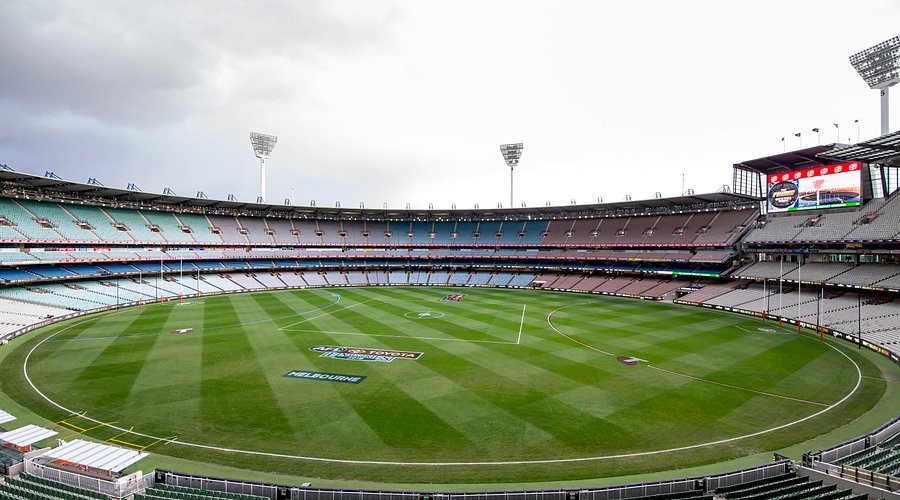
With a capacity of 100,000, the MCG—fondly known as “the G”—is more than just a stadium. For many Australians, it’s sacred ground, hosting cricket in summer and AFL (Australian Football League) in winter. It’s one of the world’s greatest sporting venues, woven into the very fabric of Melbourne’s cultural and social identity.
Established in 1853, the MCG is one of the oldest and most storied stadiums in the world. Key moments in its timeline include:
1858: First game of Australian Rules football played here.
1877: Venue for the first-ever Test cricket match, between Australia and England.
1956: Central stadium for the Melbourne Olympic Games.
1982–1992: Installation of light towers (the oldest surviving elements of the current structure).
2006: Hosted the Commonwealth Games.
1992 & 2015: Final venue for Cricket World Cups.
The MCG was also converted into an army barracks during WWII, demonstrating its versatility and importance beyond sport.
Long before cricket fans gathered here, this land was important to local Indigenous Australians. A scar tree near the MCG marks where bark was once removed to make canoes—a tangible link to traditional land use.
Many Indigenous Australians refer to the site as the Melbourne Corroboree Ground, and some believe the traditional Aboriginal game of marngrook helped influence the development of Aussie Rules football. The Marngrook Trophy, awarded during an annual AFL match, honours this legacy.
Located within the stadium itself, the Australian Sports Museum features a wide range of interactive exhibits and artefacts, including:
Hand-written rules of Australian Rules football.
Multimedia exhibits on cricket, AFL, Olympics, and more.
Dedicated sections honouring Indigenous contributions to sport.
Game Day
Nothing beats the atmosphere of a live match. Whether it’s a Test cricket match, a Big Bash League showdown, or a Friday-night footy clash, the MCG delivers energy and excitement. Tickets can be purchased via the official MCG website.
Stadium Tours
Can’t make a match? Daily behind-the-scenes tours take visitors through player change rooms, coaches’ boxes, the famous Long Room, and even the media centre. Combine it with a ticket to the Australian Sports Museum for the best value.
Quick Tip
If you’re nearby during an AFL game and want just a taste of the action, it’s sometimes possible to enter free of charge at three-quarter time (about 90 minutes after kickoff) and catch the final 30 minutes.
Located in Yarra Park, the MCG is just a 10–15-minute walk from Federation Square. Alternatively, trams and trains from the CBD make access quick and easy via Richmond or Jolimont stations.
The MCG is more than a stadium—it’s a living museum of Australian sport, a stage for history-making moments, and a must-see for anyone visiting Melbourne.
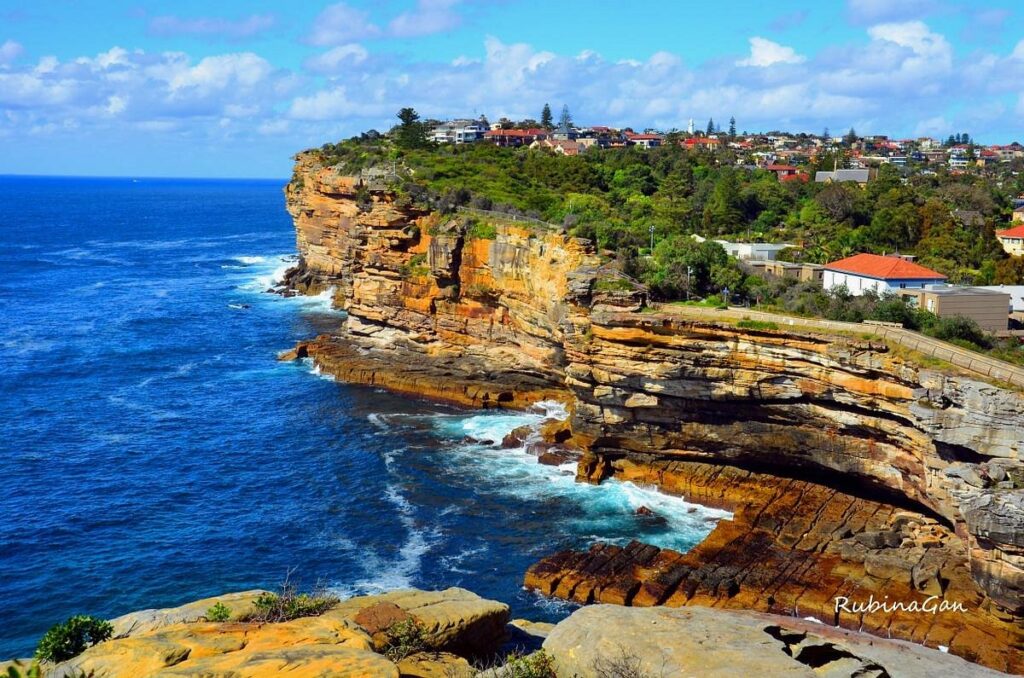
Perched on a peninsula east of the city centre and north of Bondi, Watsons Bay blends small-village charm with dramatic natural beauty. Once a humble fishing village, this harbourside suburb still retains its heritage cottages—now highly sought after—and a relaxed, beachside atmosphere.
For visitors, it’s an ideal day trip by ferry, offering coastal walks, calm beaches, great dining, and some of the best harbour views in Sydney.
Follow the South Head Heritage Trail, a short, scenic walk that takes you past the red-and-white striped Hornby Lighthouse, historic gun emplacements, and panoramic views where the Pacific Ocean meets Sydney Harbour.
On the ocean side of the peninsula, The Gap is a dramatic cliff-top lookout offering stunning coastal views. While it’s a picturesque spot, it’s also a place of quiet reflection with a somber history—signage and support services are present onsite.
Just a short stroll from the ferry terminal, Camp Cove is a sheltered beach ideal for families. With calm waters, a jetty popular for snorkelling, and a kiosk for snacks, it’s a lovely spot to relax. Public toilets are also available.
A little further along the harbour’s edge lies Lady Bay Beach, one of Sydney’s official clothing-optional beaches. Tucked beneath the cliffs, it offers privacy, serenity, and views across the harbour.
Doyles on the Beach: A Watsons Bay institution since 1885, this waterfront restaurant is famed for its seafood and harbour views. For a quicker bite, grab takeaway from Doyles on the Wharf next door.
Dunbar House: Set in a beautifully restored 1830s mansion overlooking the beach, Dunbar House serves refined breakfast, lunch, and high tea on elegant verandahs.
Beach Club at Watsons Bay Hotel: Located right by the ferry, the Watsons Bay Boutique Hotel features a vibrant beer garden that’s perfect for sunset drinks with the Harbour Bridge glowing in the distance.
Ferry:
The easiest and most scenic way to reach Watsons Bay is by ferry from Circular Quay. Services run every 30 minutes, with the journey taking about 25 minutes. Some ferries continue on to Manly, making it part of a broader harbour loop.
By Car:
It’s best to leave the car behind. Parking is limited and fills up quickly, especially on weekends.
Arrive in the afternoon, enjoy a walk along South Head, then grab a spot at the Beach Club with a drink in hand to watch the sun set over the city skyline—a classic Sydney experience.
WhatsApp us